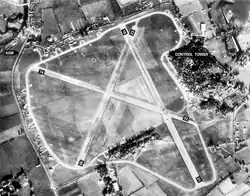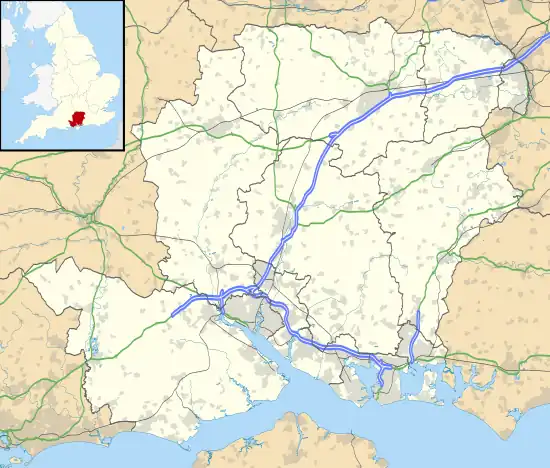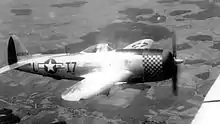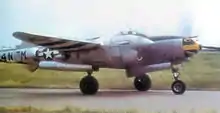| RAF Ibsley USAAF Station AAF-347 .png.webp)  | |||||||||||
|---|---|---|---|---|---|---|---|---|---|---|---|
| Ibsley, Hampshire in England | |||||||||||
 Aerial Photo of Ibsley Airfield, January 1944. Note the runway extension to the 01 runway at the south side of the airfield, with the perimeter track extension. | |||||||||||
 RAF Ibsley Shown within Hampshire | |||||||||||
| Coordinates | 50°52′46″N 001°46′50″W / 50.87944°N 1.78056°W | ||||||||||
| Type | Satellite Station | ||||||||||
| Code | IB | ||||||||||
| Site information | |||||||||||
| Owner | Air Ministry | ||||||||||
| Operator | Royal Air Force United States Army Air Forces 1942 & 1944 | ||||||||||
| Controlled by | RAF Fighter Command 1941-42 & 1942-44 & 1944-45 RAF Transport Command 1945-47 | ||||||||||
| Site history | |||||||||||
| Built | 1940/41 | ||||||||||
| In use | February 1941 - 1947 | ||||||||||
| Battles/wars | European theatre of World War II | ||||||||||
| Airfield information | |||||||||||
| Elevation | 24 metres (79 ft)[1] AMSL | ||||||||||
| |||||||||||
Royal Air Force Ibsley or more simply RAF Ibsley is a former Royal Air Force station in Hampshire, England. The airfield is near the village of Ibsley, about 2 miles (3 km) north of Ringwood and about 85 miles (137 km) southwest of London.
A perimeter track with three runways were laid out and 18 fighter pens allowing 46 fighters to stand in relative safety. 12 Blister and two Bellman hangars were built and ten dispersed accommodation sites were laid out to the north for the airmen & women. A double cupola Battle Head Quarters, two Control Towers (one small and one large)[2]
History
Royal Air Force
The airfield was initially used by No. 32 Squadron RAF with Hawker Hurricanes, followed by No. 118 Squadron RAF with Supermarine Spitfires.[3]
In 1941 it was used as a location for the film The First of the Few.[4]
The following units were here at some point:[5]
- No. 32 Squadron RAF (1941)
- No. 66 Squadron RAF (1942-43)
- No. 118 Squadron RAF (1942-43)
- No. 124 Squadron RAF
- No. 129 Squadron RAF (1943)
- No. 165 Squadron RAF (1943)
- No. 170 Squadron RAF
- No. 175 Squadron RAF
- No. 234 Squadron RAF (1941-42)
- No. 257 Squadron RAF
- No. 263 Squadron RAF (1943-44)
- No. 268 Squadron RAF
- No. 302 Polish Fighter Squadron (1941)
- No. 310 Squadron RAF (1943)
- No. 312 (Czechoslovak) Squadron RAF (1943-44)
- No. 313 Squadron RAF (1944)
- No. 421 Squadron RCAF (1942)
- No. 453 Squadron RAAF (1943)
- No. 501 Squadron RAF (1942)
- No. 504 Squadron RAF (1942-43)
- No. 587 Squadron RAF
- No. 616 Squadron RAF (1943)
- No 7 Flying Instructors School RAF
- No. 16 Casualty Air Evacuation Unit
- No. 17 Casualty Air Evacuation Unit
- No. 21 Sector RAF
- No. 134 (Czech) Airfield
- No. 147 (Night Fighter) Wing RAF
- No. 150 Staging Post
- No. 160 Staging Post
- No. 200 Staging Post
- No. 201 Staging Post
- No. 302 (Transport) Wing RAF
- No. 2763 Squadron RAF Regiment
- No. 2772 Squadron RAF Regiment
- No. 2800 Squadron RAF Regiment
- No. 2888 Squadron RAF Regiment
- No. 4043 Anti-Aircraft Flight RAF Regiment
- Glider Pick-up Training Flight
Ibsley was also used, for short periods, in 1942 and 1944, by the United States Army Air Forces[6]
United States Army Air Forces use
Ibsley was known as USAAF Station AAF-347 for security reasons by the USAAF during the war, and by which it was referred to instead of location. Its USAAF Station Code was "IB".
USAAF Station Units assigned to RAF Ibsley were:[7]
- 327th Service Group[8]
- 329th and 79th Service Squadrons; HHS 327th Service Group
- 21st Weather Squadron
- 32nd Mobile Reclamation and Repair Squadron
- 3rd Radio Squadron
- 40th Mobile Communications Squadron
- 83rd Airdrome Squadron
- 98th Station Complement Squadron
- Headquarters & Headquarters Squadron (70th Fighter Wing)
Regular Army Station Units included:
- 555th Signal Aircraft Warning Battalion
- 692nd Quartermaster Battalion
- 926th Signal Battalion
- 1113th Signal Company
- 1180th Quartermaster Company
- 1292nd Military Police Company
- 1829th Ordnance Supply & Maintenance Company
- 2200th Quartermaster Truck Company
- 332nd Signal Company
- 807th Chemical Company (Air Operations)
- 878th Signal Depot Company
- 900th Signal Depot Company
1st Fighter Group
The first USAAF unit to use Ibsley was the Eighth Air Force 1st Fighter Group, equipped with Lockheed P-38 Lightnings. The 1st FG arrived from RAF Goxhill on 24 August 1942. Tactical squadrons of the group and squadron fuselage codes were:
- 27th Fighter Squadron (HV)
- 71st Fighter Squadron (LM)
- 94th Fighter Squadron (UN)
The stay of the 1st FG was short, being assigned to Twelfth Air Force for duty in the Mediterranean theater in support of the Operation Torch North African landings.
On 16 October 1943 RAF Ibsley was allocated to the Ninth Air Force.
48th Fighter Group


With construction completed, on 29 March 1944 the Ninth Air Force 48th Fighter Group arrived at Ibsley from Waterboro AAF, South Carolina (32°55′19″N 80°38′00″W / 32.921817°N 80.633297°W). The 48th flew the Republic P-47 Thunderbolt and had the following fighter squadrons and fuselage codes:
- 492d Fighter Squadron (F4)
- 493d Fighter Squadron (I7)
- 494th Fighter Squadron (6M)
The 48th was a group of Ninth Air Force's 70th Fighter Wing, IX Tactical Air Command. Ibsley continued to be used by the 48th FG until 4 July when the last personnel left.
367th Fighter Group

Arriving on the heels of the departing 48th FG, the 367th Fighter Group arrived at Ibsley on 6 July 1944 from RAF Stoney Cross. The 367th flew Lockheed P-38 Lightnings. Tactical squadrons of the group and squadron fuselage codes were:
- 392d Fighter Squadron (H5)
- 393d Fighter Squadron (8L)
- 394th Fighter Squadron (4N)
The 367th was a group of Ninth Air Force's 70th Fighter Wing, IX Tactical Air Command. The 392d and 393d and 394th Fighter Squadrons went to Carentan (ALG A-10), Cretteville (ALG A-14) and Reuxeville (ALG A-6) respectively.
Current use
Today the airfield consists mostly of a series of gravel pits and large landscaped lakes. One lake is overlooked by the derelict, windowless control tower, although exciting plans for The Landmark Trust to restore and repurpose this building as holiday accommodation were revealed by The Guardian newspaper in July 2023. A very small section of the end of runway 01 still exists south of Ellingham Drove at the southern part of the airfield.
A small memorial is located near the control tower 50°52′45″N 001°46′34.00″W / 50.87917°N 1.7761111°W.
See also
References
![]() This article incorporates public domain material from the Air Force Historical Research Agency
This article incorporates public domain material from the Air Force Historical Research Agency
Citations
- ↑ Falconer 1998, p. 53.
- ↑ "RAF Ibsley, Hampshire Airfield Site".
- ↑ "RAF Ibsley – Real New Forest Guide". 14 April 2020.
- ↑ "RAF Ibsley – Real New Forest Guide". 14 April 2020.
- ↑ "Ibsley". Airfields of Britain Conservation Trust. Retrieved 28 June 2020.
- ↑ http://www.rafibsley.co.uk/
- ↑ "Ibsley". American Air Museum in Britain. Retrieved 16 March 2015.
- ↑ "327th Service Group". American Air Museum in Britain. Retrieved 16 March 2015.
Bibliography
- Falconer, J (1998). RAF Fighter Airfields of World War 2. UK: Ian Allan Publishing. ISBN 0-7110-2175-9.
- Freeman, Roger A. (1994) UK Airfields of the Ninth: Then and Now 1994. After the Battle ISBN 0-900913-80-0
- Freeman, Roger A. (1996) The Ninth Air Force in Colour: UK and the Continent-World War Two. After the Battle ISBN 1-85409-272-3
- Maurer, Maurer (1983). Air Force Combat Units Of World War II. Maxwell AFB, Alabama: Office of Air Force History. ISBN 0-89201-092-4.
- www.controltowers.co.uk RAF Ibsley
- British Automobile Association (AA), (1978), Complete Atlas of Britain, ISBN 0-86145-005-1
.svg.png.webp)